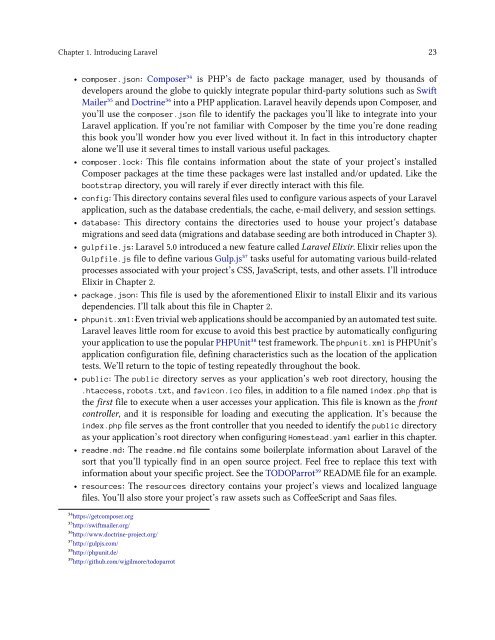easylaravel-sample
You also want an ePaper? Increase the reach of your titles
YUMPU automatically turns print PDFs into web optimized ePapers that Google loves.
Chapter 1. Introducing Laravel 23<br />
• composer.json: Composer³⁴ is PHP’s de facto package manager, used by thousands of<br />
developers around the globe to quickly integrate popular third-party solutions such as Swift<br />
Mailer³⁵ and Doctrine³⁶ into a PHP application. Laravel heavily depends upon Composer, and<br />
you’ll use the composer.json file to identify the packages you’ll like to integrate into your<br />
Laravel application. If you’re not familiar with Composer by the time you’re done reading<br />
this book you’ll wonder how you ever lived without it. In fact in this introductory chapter<br />
alone we’ll use it several times to install various useful packages.<br />
• composer.lock: This file contains information about the state of your project’s installed<br />
Composer packages at the time these packages were last installed and/or updated. Like the<br />
bootstrap directory, you will rarely if ever directly interact with this file.<br />
• config: This directory contains several files used to configure various aspects of your Laravel<br />
application, such as the database credentials, the cache, e-mail delivery, and session settings.<br />
• database: This directory contains the directories used to house your project’s database<br />
migrations and seed data (migrations and database seeding are both introduced in Chapter 3).<br />
• gulpfile.js: Laravel 5.0 introduced a new feature called Laravel Elixir. Elixir relies upon the<br />
Gulpfile.js file to define various Gulp.js³⁷ tasks useful for automating various build-related<br />
processes associated with your project’s CSS, JavaScript, tests, and other assets. I’ll introduce<br />
Elixir in Chapter 2.<br />
• package.json: This file is used by the aforementioned Elixir to install Elixir and its various<br />
dependencies. I’ll talk about this file in Chapter 2.<br />
• phpunit.xml: Even trivial web applications should be accompanied by an automated test suite.<br />
Laravel leaves little room for excuse to avoid this best practice by automatically configuring<br />
your application to use the popular PHPUnit³⁸ test framework. The phpunit.xml is PHPUnit’s<br />
application configuration file, defining characteristics such as the location of the application<br />
tests. We’ll return to the topic of testing repeatedly throughout the book.<br />
• public: The public directory serves as your application’s web root directory, housing the<br />
.htaccess, robots.txt, and favicon.ico files, in addition to a file named index.php that is<br />
the first file to execute when a user accesses your application. This file is known as the front<br />
controller, and it is responsible for loading and executing the application. It’s because the<br />
index.php file serves as the front controller that you needed to identify the public directory<br />
as your application’s root directory when configuring Homestead.yaml earlier in this chapter.<br />
• readme.md: The readme.md file contains some boilerplate information about Laravel of the<br />
sort that you’ll typically find in an open source project. Feel free to replace this text with<br />
information about your specific project. See the TODOParrot³⁹ README file for an example.<br />
• resources: The resources directory contains your project’s views and localized language<br />
files. You’ll also store your project’s raw assets such as CoffeeScript and Saas files.<br />
³⁴https://getcomposer.org<br />
³⁵http://swiftmailer.org/<br />
³⁶http://www.doctrine-project.org/<br />
³⁷http://gulpjs.com/<br />
³⁸http://phpunit.de/<br />
³⁹http://github.com/wjgilmore/todoparrot



